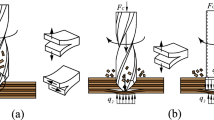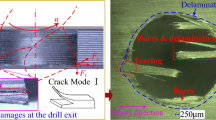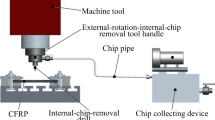Abstract
Interlaminar drilling of CFRP is a specialized drilling technique that is used to maintain the structural integrity of the composite material in specific applications where high performance and durability are critical. The outlet damage has important effects on the connection reliability and service life of components. In this work, the experiments for interlaminar drilling of CFRP were designed, the thrust force during drilling process and the damage morphologies of drilling outlet were extracted, the comprehensive damage factor was proposed, and the formation mechanism of outlet damage was analyzed. In addition, the effects of machining parameters on thrust force and outlet damage were further revealed. The results show that the time-varying curve of thrust force in interlaminar drilling has the same trend as the conventional drilling, but the thrust force in conventional drilling is lower than that in interlaminar drilling. The outlet damage in interlaminar drilling is related to the fiber cutting angles (FCAs). The tear damage at the FCA of 90° is the most obvious. The burrs damage mainly occurs in the fiber layers perpendicular to the feed direction and is concentrated in the areas of FCA of 15~105° and 195~285°. The comprehensive damage factor decreases with the increase of feed rate. Increasing the spindle speed can significantly reduce the outlet damage when the feed rate is higher than 0.17 mm/r.














Similar content being viewed by others
References
Li MJ, Gan GC, Zhang Y, Yang XJ (2018) Thermal damage of CFRP laminate in fiber laser cutting process and its impact on the mechanical behavior and strain distribution. Arch Civ Mech Eng 19:1511–1522. https://doi.org/10.1016/j.acme.2019.08.005
John KM, Thirymalai Kumaran S (2020) Backup support technique towards damage-free drilling of composite materials: a review. Int J Lightweight Mater Manuf 3:357–364. https://doi.org/10.1016/j.ijlmm.2020.06.001
Fu R, Jia ZY, Wang FJ, Jin Y, Sun D, Yang LJ, Cheng D (2018) Drill-exit temperature characteristics in drilling of UD and MD CFRP composites based on infrared thermography. Int J Mach Tool Manu 135:24–37. https://doi.org/10.1016/j.ijmachtools.2018.08.002
Xu JY, Li C, Mi SP, An QL, Chen M (2018) Study of drilling-induced defects for CFRP composites using new criteria. Compos Struct 201:1076–1087. https://doi.org/10.1016/j.compstruct.2018.06.051
Chen LM, Li MJ, Yang XJ, Li B (2020) Thermal defect characterization and heat conduction modeling during fiber laser cutting carbon fiber reinforced polymer laminates. Arch Civ Mech Eng 20:61. https://doi.org/10.1007/s43452-020-00064-8
Zhang BY, Wang FJ, Wang Q, Zhao (2021) Novel fiber fracture criteria for revealing forming mechanisms of burrs and cracking at hole-exit in drilling carbon fiber reinforced plastic. J Mater Process Technol 289:116934. https://doi.org/10.1016/j.jmatprotec.2020.116934
Quan YM, Sun LH (2012) Surface characteristic and its mechanism of the drilled CFRP. Adv Mater Res 591-593:333–336. https://doi.org/10.4028/www.scientific.net/AMR.591-593.333
Eneyew ED, Ramulu M (2014) Experimental study of surface quality and damage when drilling unidirectional CFRP composites. J Mater Res Technol 3(4):354–362. https://doi.org/10.1016/j.jmrt.2014.10.003
An QL, Cai CY, Cai XJ, Chen M (2019) Experimental investigation on the cutting mechanism and surface generation in orthogonal cutting of UD-CFRP laminates. Compos Struct 230:111441. https://doi.org/10.1016/j.compstruct.2019.111441
Qiu XY, Li PN, Niu QL, Chen AH, Ouyang P, Li CP, Tae JK (2018) Influence of machining parameters and tool structure on cutting force and hole wall damage in drilling CFRP with stepped drills. Int J Adv Manuf Technol 97:857–865. https://doi.org/10.1007/s00170-018-1981-2
Chen WC (1997) Some experimental investigations in the drilling of carbon fiber-reinforced plastic (CFRP) composite laminates. Int J Mach Tools Manuf 37(8):1097–1108. https://doi.org/10.1016/S0890-6955(96)00095-8
Faraz A, Biermann D, Weinert K (2009) Cutting edge rounding: an innovative tool wear criterion in drilling CFRP composite laminates. Int J Mach Tools Manuf 49(15):1185–1196. https://doi.org/10.1016/j.ijmachtools.2009.08.002
Davim JP, Rubio JC, Abrao A (2007) A novel approach based on digital image analysis to evaluate the delamination factor after drilling composite laminates. Compos Sci Technol 67(9):1939–1945. https://doi.org/10.1016/j.compscitech.2006.10.009
Li M, Huang M, Jiang X, Kuo C, Yang X (2018) Study on burr occurrence and surface integrity during slot milling of multidirectional and plain woven CFRPs. Int J Adv Manuf Technol 97:163–173. https://doi.org/10.1007/s00170-018-1937-6
Sugita N, Shu L, Kimura K, Arai G, Arai K (2019) Dedicated drill design for reduction in burr and delamination during the drilling of composite materials. CIRP Ann 68(1):89–92. https://doi.org/10.1016/j.cirp.2019.04.094
Xu JY, Yin YK, Paulo Davim J, Li LF, Ji M, Geier N, er al. (2022) A critical review addressing the drilling-induced damage issues for CFRP composites. Compos Struct 294:115594. https://doi.org/10.1016/j.compstruct.2022.115594
Luís Miguel PD, João Manuel RST, Victor Hugo CA, Daniel JSG (2013) Damage evaluation of drilled carbon/epoxy laminates based on area assessment methods. Compos Struct 96:576–583. https://doi.org/10.1016/j.compstruct.2012.08.003
Romoli L, Lutey AHA (2019) Quality monitoring and control for drilling of CFRP laminates. J Manuf Process 40:16–26. https://doi.org/10.1016/j.jmapro.2019.02.028
Wang D, Jiao F, Mao XS (2020) Mechanics of thrust force on chisel edge in carbon fiber reinforced polymer (CFRP) drilling based on bending failure theory. Int J Mech Sci 169:105336. https://doi.org/10.1016/j.ijmecsci.2019.105336
Grilo TJ, Paulo RMF, Silva CRM, Davim JP (2013) Experimental delamination analyses of CFRPs using different drill geometries. Compos Part B-eng 45(1):1344–1350. https://doi.org/10.1016/j.compositesb.2012.07.057
Hwang JY, Ahn DG (2020) Effects of carbide substrate properties and diamond coating morphology on drilling performance of CFRP composite. J Manuf Process 58:1274–1284. https://doi.org/10.1016/j.jmapro.2020.09.028
Geier N, Szalay T, Takács M (2019) Analysis of thrust force and characteristics of uncut fibres at non-conventional oriented drilling of unidirectional carbon fibre-reinforced plastic (UD-CFRP) composite laminates. Int J Adv Manuf Technol 100:3139–3154. https://doi.org/10.1007/s00170-018-2895-8
Shunmugesh K, Panneerselvam K (2016) Machinability study of carbon fiber reinforced polymer in the longitudinal and transverse direction and optimization of process parameters using PSO–GSA. End Sci Technol 19:1552–1563. https://doi.org/10.1016/j.jestch.2016.04.012
Li SJ, Dai LY, Li CP, Rong C, Qiu XY, Li PN, Tae JK (2022) Prediction model of chisel edge thrust force and material damage mechanism for interlaminar-direction drilling of UD-CFRP composite laminates. Compos Struct 298:116023. https://doi.org/10.1016/j.compstruct.2022.116023
Xu JY, Ji M, Davim JP, Chen M, Mansori ME, Krishnaraj V (2020) Comparative study of minimum quantity lubrication and dry drilling of CFRP/titanium stacks using TiAlN and diamond coated drills. Compos Struct 234:111727. https://doi.org/10.1016/j.compstruct.2019.111727
Qiu XY, Li PN, Li CP, Niu QL, Chen AH, Ouyang PR, Tae JK (2018) Study on chisel edge drilling behavior and step drill structure on delamination in drilling CFRP. Compos Struct 203:404–413. https://doi.org/10.1016/j.compstruct.2018.07.007
Durão LMP, Gonçalves DJS, Tavares JMRS, Albuquerque VHC, Aguiar Vieira A, Torres Marques A (2010) Drilling tool geometry evaluation for reinforced composite laminates. Compos Struct 92:1545–1550. https://doi.org/10.1016/j.compstruct.2009.10.035
Kim J, Kim YB, Seo JW, Park HW (2019) Deburring drilled holes in CFRP composites with large pulsed electron beam (LPEB) irradiation. J Manuf Process 40:68–75. https://doi.org/10.1016/j.jmapro.2019.03.001
Geier N, Póka GY, Szalay T (2018) Direct monitoring of hole damage in carbon fibre-reinforced polymer (CFRP) composites. Mater Sci Eng 448:012003. https://doi.org/10.1088/1757-899X/448/1/012003
Voβ R, Henerichs M, Rupp S, Kuster F, Wegener K (2016) Evaluation of bore exit quality for fibre reinforced plastics including delamination and uncut fibres. CIRP J Manuf Sci Tec 12:56–66. https://doi.org/10.1016/j.cirpj.2015.09.003
Merino-Pérez JL, Royer R, Merson E, Lockwood A, Ayvar-Soberanis S, Marshall MB (2016) Influence of workpiece constituents and cutting speed on the cutting forces developed in the conventional drilling of CFRP composites. Compos Struct 140:621–629. https://doi.org/10.1016/j.compstruct.2016.01.008
Geier N, Szalay T (2017) Optimisation of process parameters for the orbital and conventional drilling of uni-directional carbon fibre-reinforced polymers (UD-CFRP). Measurement 110:319–334. https://doi.org/10.1016/j.measurement.2017.07.007
Iliescu D, Gehin D, Gutierrez ME, Girot F (2010) Modeling and tool wear in drilling of CFRP. Int J Mach Tool Manu 50:204–213. https://doi.org/10.1016/j.ijmachtools.2009.10.004
Zhang L, Liu Z, Tian W, Liao WH (2015) Experimental studies on the performance of different structure tools in drilling CFRP/Al alloy stacks. Int J Adv Manuf Technol 81:241–251. https://doi.org/10.1007/s00170-015-6955-z
Wan M, Li SE, Yuan H, Zhang WH (2019) Cutting force modelling in machining of fiber-reinforced polymer matrix composites (PMCs): a review. Compos A: Appl Sci Manuf 117:34–55. https://doi.org/10.1016/j.compositesa.2018.11.003
Barten HJ (1944) On the deflection of a cantilever beam. Q Appl Math 2(2):168–171. https://doi.org/10.2307/43633452
Su YL (2019) Effect of the cutting speed on the cutting mechanism in machining CFRP. Compos Struct 220:662–676. https://doi.org/10.1016/j.compstruct.2019.04.052
Funding
This study was supported by the National Natural Science Foundation of China (No. 51975208, No. 52275423, No. 52105442, and No. 51905169) and the Natural Science Foundation of Hunan Province (No. 2020JJ4301). Also, it was partially supported by the National Research Foundation of Korea (NRF) grant, which is funded by the Korean Government (MSIT) (NRF-2020R1A2B5B02001755).
Author information
Authors and Affiliations
Corresponding authors
Ethics declarations
Competing interests
The authors declare no competing interests.
Additional information
Publisher’s Note
Springer Nature remains neutral with regard to jurisdictional claims in published maps and institutional affiliations.
Rights and permissions
Springer Nature or its licensor (e.g. a society or other partner) holds exclusive rights to this article under a publishing agreement with the author(s) or other rightsholder(s); author self-archiving of the accepted manuscript version of this article is solely governed by the terms of such publishing agreement and applicable law.
About this article
Cite this article
Li, S., Li, Q., Dai, L. et al. Formation mechanism of outlet damage in interlaminar drilling of CFRP. Int J Adv Manuf Technol 129, 5117–5133 (2023). https://doi.org/10.1007/s00170-023-12643-z
Received:
Accepted:
Published:
Issue Date:
DOI: https://doi.org/10.1007/s00170-023-12643-z




